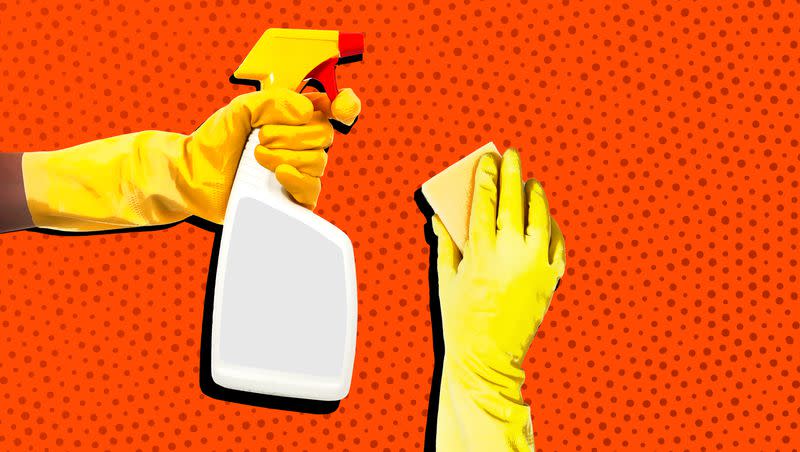The surprising places where germs lurk at home

Asked what’s the germiest surface in the house, you might say the toilet seat. But you’d likely be wrong.
CNN did a quick, “nonscientific” experiment, guided by a food safety and thus germ expert, Paul Dawson of Clemson University, taking samples in the home of five people. Four days after specific surfaces were thoroughly cleaned, they swabbed them and sent them off to the lab to see what they could grow in petri dishes.
Ick. There was plenty to see from the swabs of the kitchen sink drain, the bathroom toilet seat, the front door entryway, the kitchen countertop and the bathroom faucet.
Kitchen surfaces are plenty germy and should be cleaned weekly with a solution containing diluted bleach, the video report said. The front door entryway was a solid mass of bacteria and Dawson suggests placing a door mat that can be easily cleaned.
Microbes, including bacteria, are everywhere, per the report. But Dawson said that the toilet seat is likely the cleanest place in most homes. People take care to clean it regularly because, well, gross.
He also pointed out that just because something is bacteria doesn’t mean it will cause harm. But some definitely do.
Different places, different germs
Germs — including what they are and where they hide out — have long been cause for concern. The University of Colorado at Boulder found more than 9,000 species of microbes, bacteria and fungi when it looked at dust samples from 1,200 households, as reported by ZME Science. It broke down to more than 2,000 different species of fungus and 7,000 types of bacteria.
What kind of minuscule germ critters were found depends on “where the home is located, the gender of the people living inside and whether or not pets are present,” the article said. Gender mattered because some types of bacteria are more common in either men or in women. And they speculated differences in hygiene might make some difference there, too.
And since pets change the bacteria of a home, the scientists could guess with remarkable accuracy which homes had cats or dogs.
But again, most of the microorganisms and fungi were harmless, per ZME Science.
Germs in unexpected places
Ponder this surprising bit of bacteria news: A study in the Journal of Food Protection early this year said that spice jars are possibly the germiest thing in your oh-so-germy kitchen. As Taste of Home put it when reporting on the study, “Simply put, we’ve all been taught to wipe down our cutting boards and counters, but has anyone ever told you to wipe down your spice jars after using them? Probably not.”
You handle food — in their example, raw ground turkey — then grab those jars, flip open the lid and sprinkle or pour. It’s a hands-on cross-contamination event.
Related
While lots of contamination occurred all over the kitchen in that study, “by a large margin, the spice jars contained the most germs,” followed by cutting boards and trash can lids.
Reader’s Digest and the Daily Mail also both offer lists of places where germs lurk, waiting to be passed on, including some that likely never crossed your mind.
Pens are one you might not think much about — but you should. The Reader’s Digest article said the clipboard pen in a doctor’s office can be positively gross.
“Researchers found the clipboard pen has more than 46,000 times more germs than the average toilet seat,” the article said.
So take your own pen with you when you venture into the world. Pens in public places are probably not very clean.
Cellphones and their chargers can be pretty gross, too, per Reader’s Digest. The former is close to your face — or that of anyone you let borrow it. And their hands. And your purse or pocket or the table in the restaurant or the counter at the check stand. You get the idea. Keep it to yourself and clean that screen periodically.
Reader’s Digest also points out that most people don’t clean their nail clippers regularly, but they do share them with friends and family sometimes. “Plus, you never know what someone else touched before they touched your nail clippers.”
Kettle handles and recipe books are something we touch often but seldom clean, per the Daily Mail.
Pet bowls and bedding need to be cleaned as often as the human versions, per the USPCA by way of Daily Mail. They can be “a breeding ground for salmonella and E. coli that can make you and your pets ill,” especially if they’re left outside. Then they need to be cleaned twice a day.
The Digest also says to stop sharing hand sanitizer. And if you must, pour some into your pal’s hand, instead of handing over the bottle. Your hands may be germ-free — but the bottle isn’t unless you sanitize it each time it’s used. Most people don’t.
What your shoes track in: Parents beware
“Bacteria, including E. coli, is found on the majority of shoes,” Dr. Cindy Geller, a pediatrician at University of Utah Health, said in a 2015 Healthfeed story. She said shoe bottoms can collect bacteria from restroom floors and outdoors, and they can transfer that into your home or other places. It’s a case of where you were, germs can be collected.
“This is especially a concern in homes where an infant or toddler is crawling around, because everything they get on their hands eventually goes into their mouth,” Geller said.
She suggested having different shoes or slippers for home and away. That prevents tracking harmful germs from outside.

